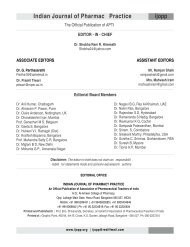Jul-Sep, 2012 - Indian Journal of Pharmacy Practice
Jul-Sep, 2012 - Indian Journal of Pharmacy Practice
Jul-Sep, 2012 - Indian Journal of Pharmacy Practice
You also want an ePaper? Increase the reach of your titles
YUMPU automatically turns print PDFs into web optimized ePapers that Google loves.
Mahendra Kumar BJ - Drug Induced Syndromes: An Overviewand symptoms <strong>of</strong> infection. Use <strong>of</strong> Vasoactive agents(Pentoxyphylline) together with hyperbaric oxygen may bebeneficial considering the vascular pathogenesis. Vasospasmmay be relieved by the phosphodiesterase inhibiting action <strong>of</strong>pentoxyphylline. Topical corticosteroids are effective foracute tissue inflammation. Wound care, debridement,dressings, and flap reconstruction are ideal surgical measures.Failure to recognize the extent <strong>of</strong> fat necrosis and poor bloodsupply leads to inadequate debridement and poor woundhealing. The patients are then prone to repetitive cycles <strong>of</strong>infection leading to extensive scarring, s<strong>of</strong>t tissue23indentation, and unsightly skin grafts.Warfarin-Induced Skin Necrosis: Warfarin-induced skinnecrosis due to oral anti-coagulation therapy causes injury tothe skin. Cutaneous injury from warfarin begins as localizedparesthesias with an erythematous flush, progresses topetechiae and hemorrhagic bullae, and may eventually result24in full-thickness skin necrosis.24, 25, 26Causative drug: Warfarin.Symptoms: Patients may initially experience localparesthesias with an erythematous flush followed by intensepain and rapid development and coalescence <strong>of</strong> petechiae,with concomitant accumulation <strong>of</strong> subcutaneous edemaresulting in a peaud'orange appearance. During the first 24hours after the first sign <strong>of</strong> skin lesions, hemorrhagic bullaemay occur, which signals irreversible tissue injury. Full-24thickness skin necrosis is the end stage <strong>of</strong> cutaneous injury.(Fig 5)Treatment: Vitamin K intravenously and fresh frozen plasma(FFP) can be given to the patient to reverse the effects <strong>of</strong> the24warfarin.Sweet Syndrome: Sweet syndrome is a condition associatedwith autoimmune phenomena including relapsingpolychondritis, drug-induced lupus, and development <strong>of</strong>27Anti-Neutrophil Cytoplasmic Antibodies (ANCAs).Causative drugs: Abacavir, All-Trans Retinoic Acid,Bortezomib, Carbamazapine, Celecoxib, Clozapine,Dicl<strong>of</strong>enac, Diazepam, Furosemide, Hydralazine, Imatinib,Lenalidomide, Minocycline, Nitr<strong>of</strong>urantoin, Norfloxacin,Ofloxacin, Pegfilgastrin, Propylthiouracil, Quinupristin,27Dalfopristin, Trimethoprim-Sulfamethoxazole.Symptoms: Rapid onset <strong>of</strong> fever, leukocytosis, painfulerythematous and edematous papules, plaques and nodules27infiltrated by neutrophils.Treatment: Causative drugs should be suspended andsystemic corticosteroids can be given to the patient for the28management <strong>of</strong> lesions.Stevens - Johnson syndrome (SJS): SJS is a wellrecognizedimmune complex mediated hypersensitivityreaction that affects all age groups. It has classic systemic,29mucosal and dermatologic manifestations.Causative drugs: Ibupr<strong>of</strong>en, Allopurinol, Chloroquine,Penicillamine, Sulfasalazine, Carbamazepine, Etosuximide,Phenobarbital, Phenytoin, Valpoic Acid, Amoxicillin,Imipenem, Cipr<strong>of</strong>loxacin, Clindamycin, Doxycyclin,Erythromycin, Sulfadiazine, Sulfamethoxazole-Trimethoprim, Dapsone, Fluconazole, Nystatin, Nevirapine,Abacavir, Efavirenz, Tamoxifen, Verapamil, Enalapril,30,31,32Acetazolamide.Symptoms: Erythema with bullous, eroded lesions <strong>of</strong> skin and29mucous membrane and cholestatic liver disease.Treatment: Withdrawal <strong>of</strong> the causative drugs, rapidlyinitiating supportive care in an appropriate setting and themanagement <strong>of</strong> fluid and electrolyte requirements. Treatmentstarted with IV fluids and combination <strong>of</strong> corticosteroid is29used.Toxic Epidermal Necrolysis (Lyell Syndrome/TEN): TENis a severe adverse cutaneous drug reaction thatpredominantly involve the skin and mucous membranes. It isan autoimmune blistering disease, including linear IgAdermatosis and paraneoplastic pemphigus but alsopemphigus vulgaris and bullous pemphigoid, acutegeneralized exanthematous pustulosis (AGEP), disseminatedfixed bullous drug eruption and staphyloccocal scalded skinsyndrome (SSSS).Causative drugs: Sulfonamides, Pyrazolones, Barbiturates,Ibupr<strong>of</strong>en, Allopurinol and Carbamazepine.Symptoms: Hyper and hypopigmentation <strong>of</strong> the skin, naildystrophies, ocular complications, trichiasis, symblepharon,distichiasis, visual loss, entropion, ankyloblepharon,lagophthalmos and corneal ulceration.Treatment: Prompt identification and withdrawal <strong>of</strong> thecausative drug, systemic steroids, high-dose intravenousimmunoglobulin Ciclosporin, and Cyclophosphamide31(CPP).Rabbit's Syndrome (RS): RS is a rare movement disordergenerally associated with prolonged use <strong>of</strong> antipsychoticscharacterized by involuntary, rhythmic, fast and finemovements <strong>of</strong> the oral and masticatory muscles along thevertical axis <strong>of</strong> the mouth. It takes its name from an unusual33resemblance to the chewing motions <strong>of</strong> rabbits.Causative drugs: Methotrimipramine, Benzotropine,M e s o r i d a z i n e , C l o r a z e p a t e , C h l o r p r o m a z i n e ,Trifluoperazine, Lithium, Clocapramine, Propericiazine,Levopromazine, Bromperidol, Sulpiride, Thioridazine,<strong>Indian</strong> <strong>Journal</strong> <strong>of</strong> <strong>Pharmacy</strong> <strong>Practice</strong> Volume 5 Issue 3 <strong>Jul</strong> - <strong>Sep</strong>, <strong>2012</strong> 15
















